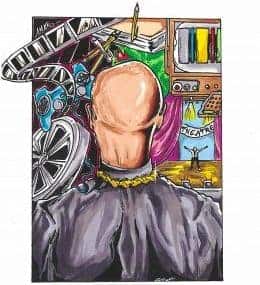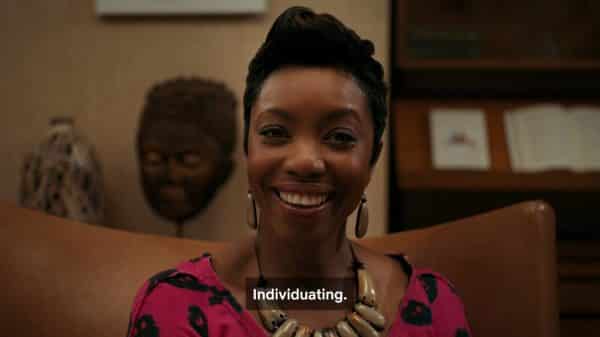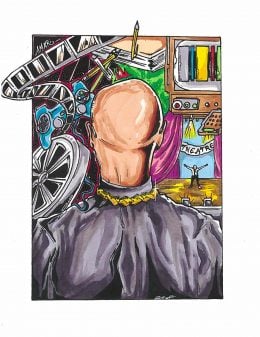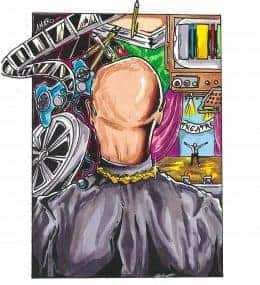She’s Gotta Have It: Season 2, Episode 9 “#IAmYourMirror” [Season Finale] – Recap, Review (with Spoilers)
Nola hosts an art show featuring familiar pieces, but it is one statement of a piece which causes a fuss.
![Title Card - She's Gotta Have It Season 2, Episode 9 #IAmYourMirror [Season Finale]](https://wherever-i-look.com/wp-content/uploads/2019/05/Title-Card-Shes-Gotta-Have-It-Season-2-Episode-9-IAmYourMirror-Season-Finale.jpg)
Spoiler Alert: This summary and review contains spoilers.
Additionally, some images and text may include affiliate links, meaning we may earn a commission or receive products if you make a purchase.
Nola hosts an art show featuring familiar pieces, but it is one statement of a piece which causes a fuss.
| Network | |
| Netflix | |
| Director(s) | Spike Lee |
| Writer(s) | Eisa Davis |
| Air Date | 5/24/2019 |
Images and text in this post may contain affiliate links which, if a purchase is made, we’ll earn money or products from the company. Affiliate links and external links have an upward facing, superscript, arrow.
Hello To Old Friends: Opal, Nola, Greer, Mars, Jamie
Using the earWave money, Nola has a DIY art show, and it features all you’d expect to see. Jamie shows up, but doesn’t say much, Mars stirs things up a bit, and Greer appears as well. Leading to them, like in season one, bickering a bit but nothing of substance. But, to much surprise, Opal shows up as well, and while Skylar tries to pull a Virgil, she doesn’t put in enough effort for reconciliation. So, ultimately, Opal and Nola might be cordial, but they aren’t getting back together.
Art Criticism: Nola, Shemekka, Clo
When it comes to Nola’s show, a lot of it is rather tame. Featured are depictions of herself, those who influence her, or photos from her trip to PR. However, one picture causes quite a stir. One which leads to the question of, when it comes to Nola, is or must all her art be for the people? Clo points out the need to question, due to the nature of the piece, is the violence something that is warranted? For in her mind, the violence isn’t something white folk deserve to see and share in their circle, and when it comes to Black folks, they don’t want to be triggered by it.
Such is the case with Shemekka who thinks the painting is irresponsible. It upsets her deeply and leads to her calling out Nola who hunches it off. Leading to comments which sound a bit elitist from Nola, in the form of Shemekka not having a name or education to affect Nola, and Shemekka, essentially, calling Nola privileged. And while this is but a small fight, it does remind you of Nola’s conversations with Olu and how, as much as she likes diversity in her friend group, it seems she likes it more for what she can get from it more than anything else.
The Black Orchid: Nola, Dr. Jamison
Yet, in the long run, Nola keeps the painting up. Why? Well, as Dr. Jamison points out, and we’ve seen throughout the series, Nola often does stuff for others. Her activism is for others, her artwork, even if largely of herself, is supposed to be an expression for others in terms of vulnerability. So making something which speaks to her, maybe gets a rise out of others, is different for many. Plus, it is about Nola, for Nola, and deals with Nola’s own healing. Something that she has run from, hidden from, and yet going to PR, talking to Lucy, hearing those drums, it seems it made her confront her trauma. So, on a canvas, she shows herself being hung by her braids, fully naked.
Which, and maybe this shows my lack of scope or how desensitized I am, didn’t seem worth the looks, shock, and vitriol at all. Unless seeing pubic hair is that offensive.
Collected Quote(s) & .Gifs
Just because I’m not loud about my pain doesn’t mean I haven’t been through some s***, okay?
— Nola
Highlights
Dr. Jamison’s Bit
Dr. Jamison’s dialog, towards the end of the episode, dealing with the path to self-actualization and individualism, is the type of writing that you have to see repeatedly. Maybe not all in one scene, but it does feel like the kind of words which evolve as you reach different stages of life. Be it you as a teen, in college, at work, with children, as your family gets, older, and etc. Her whole concept of self, outside your community, is strangely thought-provoking and pushes you, as it did with the first season, to want someone like that in your life. Be it for therapy or as a friend.
Shemekka and Clo’s Comments On Violence In Black Art
As mentioned whenever a new film with slavery or what appears to be a white savior comes about, there is a need to question the need of the story and its effect. Do we really need another film in which the endurance of a Black person being verbally, sometimes physically abused, needs to be seen on screen? Praised for its brutality as it triggers children of that person’s distant ancestors?
Also, as Shemekka said, what about being held accountable? If you portray a figure and cut out their life outside of working with some racist, are you doing them a disservice? If you highlight a white savior and ignore the structures which made it so that Black or Brown person was struggling in the first place, what are you saying? Harmony is certainly a goal, but no one wants to be portrayed as invalid when the deck was stacked against them from the start.
And in terms of Nola, even if she is the centerpiece of all her work, Nola is self-absorbed and needs to be challenged. She has to deal with the fact even what she thinks is some of her greatest work may not speak to anyone but her, and could be seen as offensive. Which, of course, is hard for Nola because Nola is privileged in the worse way.
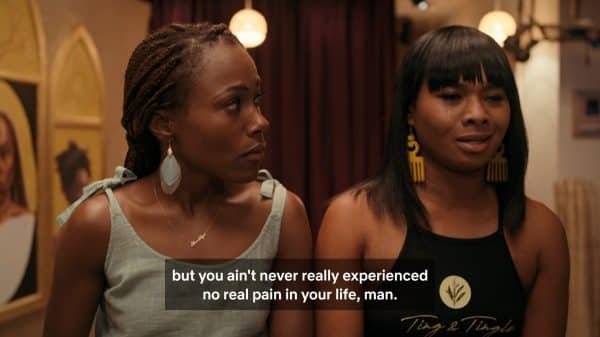 Now, this isn’t to say, as Shemekka implied, she didn’t go through anything. However, Nola for a long time was having other people pay for her things and only recently started to pay her rent on time. If it was anyone else, Miss Ella would have kicked that woman out a long time ago. Also, while Cheryl did pull up on her, largely, Nola hasn’t dealt with a huge amount of consequences for her actions. Which, for someone like Shemekka, as much as you want your friend safe, it must be frustrating that you have to work your ass off with a limited time frame while your friend is given the ability to fail in ways you can’t.
Now, this isn’t to say, as Shemekka implied, she didn’t go through anything. However, Nola for a long time was having other people pay for her things and only recently started to pay her rent on time. If it was anyone else, Miss Ella would have kicked that woman out a long time ago. Also, while Cheryl did pull up on her, largely, Nola hasn’t dealt with a huge amount of consequences for her actions. Which, for someone like Shemekka, as much as you want your friend safe, it must be frustrating that you have to work your ass off with a limited time frame while your friend is given the ability to fail in ways you can’t.
What doesn’t help the situation, however, is Nola does often uses her education as both a sword and shield. It’s how she cuts people down and how she tries to deflect criticism. Yet, with time and maturity, it seems she is realizing every critique isn’t an attack, and with success, she has to be ready for the scrutiny which comes with it. Not just from the high-siddity who can afford her prices but also those like Shemekka who, supposedly, her work is supposed to speak for in some way.
Making the big question, in the long run, is will Nola reach a point where the ones she speak for are no longer her audience? Will Nola eventually come to the point that many rappers do when those who look like you are speckled throughout your concert, but it is mostly pale faces? If not, as Clo perhaps warned, Nola reaching the point that Dave Chappelle did when he realized that he lost control of the narrative? That, in speaking on her pain, trying to speak for others, the only ones who may listen is an audience who can’t relate to the pain but enjoys the aesthetic. Is perhaps like Dean, in terms of going on and on, dissertation style, and yet completely missing the point? This is the warning Clo and Shemekka are putting out there and it’ll be interesting to see, as Nola perhaps goes mainstream, how she reacts to her work leaving the grasp of the people and being found amongst the non-Black and Brown elite.
Follow Wherever I Look on Twitter, Like us on Facebook and Subscribe to the YouTube Channel.
[ninja_tables id=”35599″]
